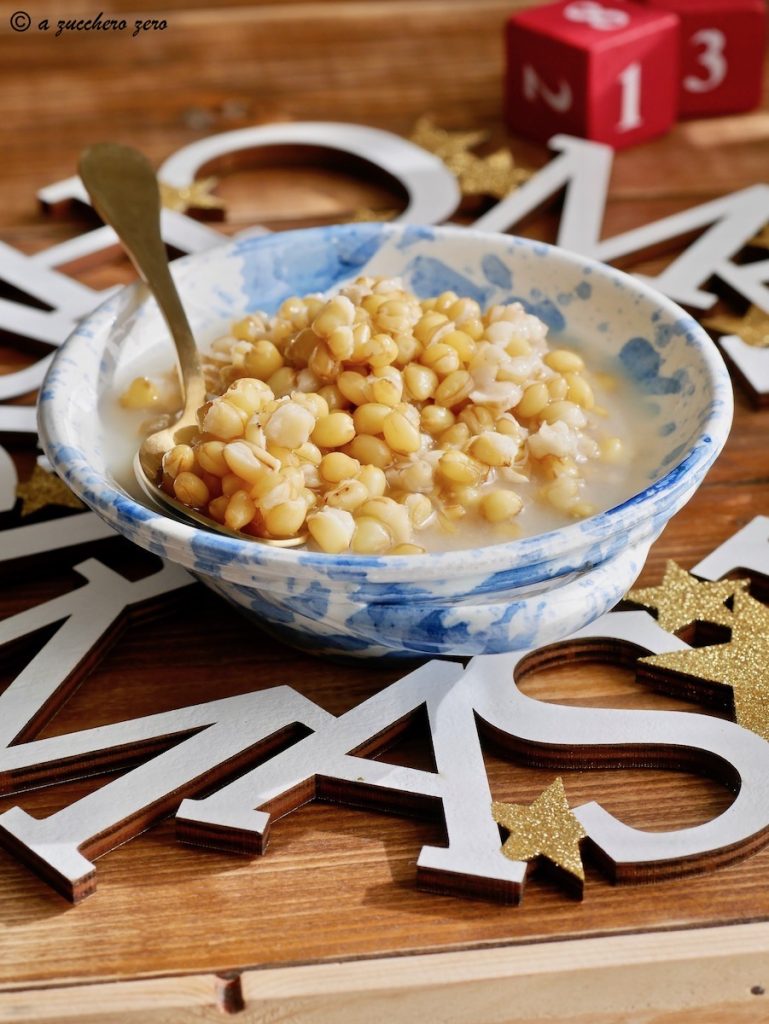Today I tell you about the cuccia of Santa Lucia which, traditionally, is consumed on the day the Saint is celebrated, that is, December 13th.
The term cuccia comes from the Greek ‘kokkía’ meaning grains.
Cuccia is boiled wheat.
Considering the soaking and cooking operations, you need to start working a few days in advance.
Alternatively, for a quick preparation, you can use pre-cooked wheat for pastiera.
Tradition speaks of a great famine and a ship loaded with wheat sent by the Saint to supply the people of Syracuse, and that the owner of the wheat-laden ships was cured of an eye disease as soon as he entered the port.
Source: The diamond on the plate by Anna Martano.
Also due to the great famine, on December 13th it is traditional not to consume bread and pasta [Santa Lucia’s fast]; the city of Palermo honors the Saint by preparing and eating arancini* of rice.
It seems that eating cuccia was a good omen, so it was and is still cooked in large quantities and distributed to relatives, friends, neighbors, and even animals.
Usually, my mom prepares it or Aunt Lina, my father’s sister, gives it to us.
I have noted the family recipe which is the basic recipe; regarding the seasoning, the variations are endless and range from sweet to savory.

- Difficulty: Medium
- Cost: Economical
- Rest time: 2 Days
- Cooking methods: Boiling
- Cuisine: Italian
Ingredients
- soft wheat (or pre-cooked wheat for pastiera)
You need to start working a few days in advance…
Alternatively, for a quick preparation, you can use pre-cooked wheat for pastiera.
Rinse the wheat and soak it in water for 48 hours.
Some add a handful of chickpeas to the wheat to symbolize Santa Lucia’s eyes.Change the water every day, so 2 times in 48 hours.
After 48 hours, rinse the wheat thoroughly.
The evening before Santa Lucia, on December 12th, cook the wheat so that it can be consumed traditionally the next day, December 13th.
If you prefer, and depending on how you plan to season the cuccia, add to the cooking water:
• citrus peels [oranges and/or lemons];
• a few bay leaves.Regarding the cooking times:
in a regular pot
• cook the wheat on low heat until the grains become plump and tender [approximately 2-3 hours] and turn off the heat as soon as they split;
in a pressure cooker
• cook the wheat for one hour.Once cooked, leave the wheat in its cooking water for the entire night in a covered pot, with a lid or with a folded blanket, so it continues cooking and cools slowly.
The next day, December 13th, the day of Santa Lucia, it will be time to eat the cuccia.
Once cold, my mother portions it and keeps some bags in the freezer.
You can bring it back to a boil to consume it hot or warm, or you can eat it cold.
After draining it, all that remains is to season it.
I have noted the family recipe which is the basic recipe.
Regarding the seasoning, the variations are endless and range from sweet to savory… not all, unfortunately, suitable for hyperglycemia!Sweet variations:
• cocoa;
• candied fruits;
• cinnamon;
• dark chocolate flakes;
• traditional custard, chocolate or flavored as desired;
• milk and sugar;
• condensed milk and sugar;
• honey;
• ricotta and sugar;
• cooked wine;
• sugar.Savory variations:
• salt and oil;
• soup with legumes.In case of hyperglycemia, I recommend the following variations:
• unsweetened cocoa;
• cinnamon;
• dark chocolate flakes;
• light chocolate cream;
• milk;
• ricotta;
• yogurt;
• salt and oil;
• soup with legumes [how to pair legumes in the diet].Don’t forget to pair it with plenty of vegetables [raw or cooked].
Include the boiled wheat in the meal as a source of carbohydrates instead of pasta or rice or treat yourself to a taste in a sweet version or dessert at the end of the meal.
For portion sizes, refer to your dietary plan.
Notes
Hyperglycemia, prediabetes, and diabetes.
Here you find dedicated recipes.
Remember:
• start the meal with a generous portion of vegetables [raw or cooked];
• a balanced meal should contain all nutrients: carbohydrates, proteins, fats & fiber;
• always prepare it respecting the proportions and combinations indicated in your food plan.
***
DO NOT COPY AND PASTE MATERIAL FROM THE BLOG generally and particularly ON SOCIAL PROFILES AND GROUPS [photos, ingredients, procedure – NOT EVEN AS A SUMMARY]: it is correct to share your photos of the recipes executed indicating the source, that is, linking the blog where it is possible to read the recipe in full.
FOR REASONS OF COPYRIGHT AND ALSO FOR THE GREAT AMOUNT OF WORK BEHIND IT.
Thank you.
FAQ (Questions and Answers)
Which wheat for cuccia?
For the preparation of cuccia, soft wheat is used.
Wheat for cuccia, where to buy?
You can buy wheat for cuccia at mills or local and typical product shops.
Alternatively, for a quick preparation, you can use pre-cooked wheat for pastiera.

